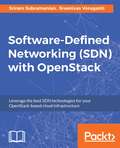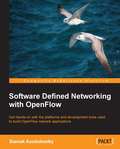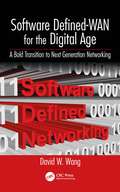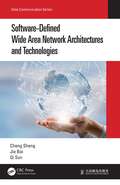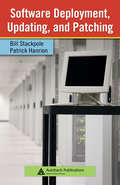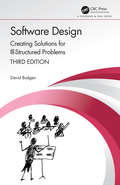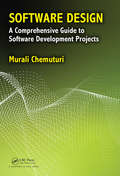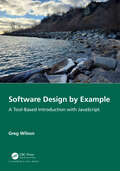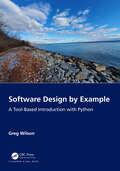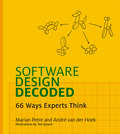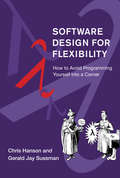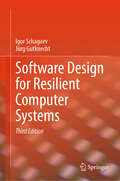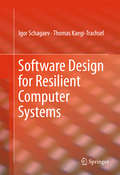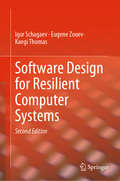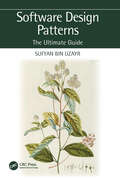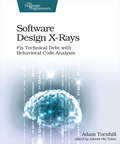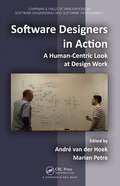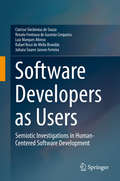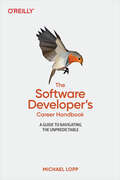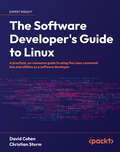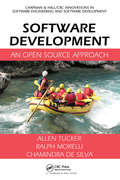- Table View
- List View
Software-Defined Networking (SDN) with OpenStack
by Sriram Subramanian Sreenivas VorugantiLeverage the best SDN technologies for your OpenStack-based cloud infrastructure About This Book * Learn how to leverage critical SDN technologies for OpenStack Networking APIs via plugins and drivers * Champion the skills of achieving complete SDN with OpenStack with specific use cases and capabilities only covered in this title * Discover exactly how you could implement cost-effective OpenStack SDN integration for your organization Who This Book Is For Administrators, and cloud operators who would like to implement Software Defined Networking on OpenStack clouds. Some prior experience of network infrastructure and networking concepts is assumed. What You Will Learn * Understand how OVS is used for Overlay networks * Get familiar with SDN Controllers with Architectural details and functionalities * Create core ODL services and understand how OpenDaylight integrates with OpenStack to provide SDN capabilities * Understand OpenContrail architecture and how it supports key SDN functionality such as Service Function Chaining (SFC) along with OpenStack * Explore Open Network Operating System (ONOS) - a carrier grade SDN platform embraced by the biggest telecom service providers * Learn about upcoming SDN technologies in OpenStack such as Dragonflow and OVN In Detail Networking is one the pillars of OpenStack and OpenStack Networking are designed to support programmability and Software-Defined Networks. OpenStack Networking has been evolving from simple APIs and functionality in Quantum to more complex capabilities in Neutron. Armed with the basic knowledge, this book will help the readers to explore popular SDN technologies, namely, OpenDaylight (ODL), OpenContrail, Open Network Operating System (ONOS) and Open Virtual Network (OVN). The first couple of chapters will provide an overview of OpenStack Networking and SDN in general. Thereafter a set of chapters are devoted to OpenDaylight (ODL), OpenContrail and their integration with OpenStack Networking. The book then introduces you to Open Network Operating System (ONOS) which is fast becoming a carrier grade SDN platform. We will conclude the book with overview of upcoming SDN projects within OpenStack namely OVN and Dragonflow. By the end of the book, the readers will be familiar with SDN technologies and know how they can be leveraged in an OpenStack based cloud. Style and approach A hands-on practical tutorial through use cases and examples for Software Defined Networking with OpenStack.
Software Defined Networking with OpenFlow
by Siamak AzodolmolkyA step-by-step, example-based guide which will help you gain hands-on experience with the platforms and debugging tools on OpenFlow.If you are a network engineer, architect, junior researcher or an application developer, this book is ideal for you. You will need to have some level of network experience, knowledge of broad networking concepts, and some familiarity with day- to- day operation of computer networks. Ideally, you should also be familiar with programing scripting/languages (especially Python and Java), and system virtualization.
Software-Defined Networking with OpenFlow - Second Edition
by Oswald Coker Siamak AzodolmolkyMaster OpenFlow concepts to improve and make your projects efficient with the help of Software-Defined Networking. About This Book • Master the required platforms and tools to build network applications with OpenFlow • Get to grips with the updated OpenFlow and build robust SDN-based solutions • An end-to-end thorough overview of open-source switches, controllers, and tools Who This Book Is For If you are a network/system administrator or a system engineer and would like to implement OpenFlow concepts and take Software-Defined Networking on your projects to the next level, then this book is for you. If you are aware of broad networking concepts, and are familiar with the day-to-day operation of computer networks, you will find this book very beneficial. What You Will Learn • Explore Software-Defined Networking and activities around SDN/OpenFlow including OpenFlow messages • Hardware and software implementations of OpenFlow switches and experiment with Mininet GUI • Learn about the role of OpenFlow in cloud computing by configuring and setting up the Neutron and Floodlight OpenFlow controller plugins • Simulate and test utilities, and familiarize yourself with OpenFlow soft switches, controllers, virtualization, and orchestration tools • Enhance and build environments for Net App development by installing VM's and tools such as Mininet and Wireshark • Learn about hardware and software switches and get a feel for active open-source projects around SDN and OpenFlow In Detail OpenFlow paves the way for an open, centrally programmable structure, thereby accelerating the effectiveness of Software-Defined Networking. Software-Defined Networking with OpenFlow, Second Edition takes you through the product cycle and gives you an in-depth description of the components and options that are available at each stage. The aim of this book is to help you implement OpenFlow concepts and improve Software-Defined Networking on your projects. You will begin by learning about building blocks and OpenFlow messages such as controller-to-switch and symmetric and asynchronous messages. Next, this book will take you through OpenFlow controllers and their existing implementations followed by network application development. Key topics include the basic environment setup, the Neutron and Floodlight OpenFlow controller, XORPlus OF13SoftSwitch, enterprise and affordable switches such as the Zodiac FX and HP2920. By the end of this book, you will be able to implement OpenFlow concepts and improve Software-Defined Networking in your projects. Style and approach This book is an easy-to-follow and pragmatic guide networking. Each topic adopts a logical approach and provides hints to help you build and deliver SDN Solutions efficiently.
Software Defined Networks: Architecture and Applications
by Anand Nayyar Bhawna Singla Preeti NagrathSOFTWARE DEFINED NETWORKS Software defined networking suggests an alternative worldview, one that comes with a new software stack to which this book is organized, with the goal of presenting a top-to-bottom tour of SDN without leaving any significant gaps that the reader might suspect can only be filled with magic or proprietary code. Software defined networking (SDN) is an architecture designed to make a network more flexible and easier to manage. SDN has been widely adopted across data centers, WANs, and access networks and serves as a foundational element of a comprehensive intent-based networking (IBN) architecture. Although SDN has so far been limited to automated provisioning and configuration, IBN now adds “translation” and “assurance” so that the complete network cycle can be automated, continuously aligning the network to business needs. In 14 chapters, this book provides a comprehensive understanding of an SDN-based network as a scalable distributed system running on commodity hardware. The reader will have a one-stop reference looking into the applications, architectures, functionalities, virtualization, security, and privacy challenges connected to SDN. Audience Researchers in software, IT, and electronic engineering as well as industry engineers and technologists working in areas such as network virtualization, Python network programming, CISCO ACI, software defined network, and cloud computing.
Software Defined Systems: Sensing, Communication and Computation (SpringerBriefs in Computer Science)
by Deze Zeng Lin Gu Shengli Pan Song GuoThis book introduces the software defined system concept, architecture, and its enabling technologies such as software defined sensor networks (SDSN), software defined radio, cloud/fog radio access networks (C/F-RAN), software defined networking (SDN), network function virtualization (NFV), software defined storage, virtualization and docker. The authors also discuss the resource allocation and task scheduling in software defined system, mainly focusing on sensing, communication, networking and computation. Related case studies on SDSN, C/F-RAN, SDN, NFV are included in this book, and the authors discuss how these technologies cooperate with each other to enable cross resource management and task scheduling in software defined system. Novel resource allocation and task scheduling algorithms are introduced and evaluated. This book targets researchers, computer scientists and engineers who are interested in the information system softwarization technologies, resource allocation and optimization algorithm design, performance evaluation and analysis, next-generation communication and networking technologies, edge computing, cloud computing and IoT. Advanced level students studying these topics will benefit from this book as well.
Software Defined-WAN for the Digital Age: A Bold Transition to Next Generation Networking
by David W. WangSD-WAN is an advanced networking approach that creates hybrid networks to integrate broadband or other network services into the corporate WAN, not only just handling general business workloads and traffic, but also being capable of maintaining the performance and security of real-time and sensitive applications. This book posits that Software Defined (SD) WAN is the answer to questions such as what changes can be made to the networking sector? What innovations can make WAN, which plays a vital integrated part of the cloud ecosystem, more cost effective, performance robust, provisioning efficient, and operation intelligent?
Software-Defined Wide Area Network Architectures and Technologies (Data Communication Series)
by Cheng Sheng Jie Bai Qi SunStarting with problems and challenges faced by enterprise WANs, Software-Defined Wide Area Network Architectures and Technologies provides a detailed description of SD-WAN’s background and basic features, as well as the system architecture, operating mechanism, and application scenarios of the SD-WAN solution based on the implementation of Huawei SD-WAN Solution. It also explains key SD-WAN technologies and analyzes real SD-WAN deployment cases, affording readers with design methods and deployment suggestions for the SD-WAN solution. The information presented in this book is easy to understand and very practical. It enables you to become adept in the SD-WAN solution’s implementation and design principles. The book is intended for ICT practitioners, such as network technical support engineers, network administrators, and network planning engineers, to use in studying theory. Furthermore, it serves as reference material for network technology enthusiasts. Authors Cheng Sheng is the Chief Architect of Huawei’s SD-WAN Solution. He has nearly 20 years of experience in network product and solution design, as well as extensive expertise in product design and development, network planning and design, and network engineering project implementation. Jie Bai is an Architect of Huawei’s SD-WAN Solution. He is well versed in Huawei security products and SD-WAN Solution and has written books such as Huawei Firewall Technology Talk as well as Huawei Anti-DDoS Technology Talk. Qi Sun is a Senior Information Architect of Huawei, and he is knowledgeable in Huawei SD-WAN Solution, CloudVPN Solution, and Cloud Management Solution. He also participated in the information architecture design and delivery of multiple solutions.
Software Deployment, Updating, and Patching
by Bill Stackpole Patrick HanrionThe deployment of software patches can be just as challenging as building entirely new workstations. Training and support issues can haunt even the most successful software launch for months. Preparing for the rigors of software deployment includes not just implementing change, but training employees, predicting and mitigating pitfalls, and managin
Software Design: Creating Solutions for Ill-Structured Problems (Chapman & Hall/CRC Innovations in Software Engineering and Software Development Series)
by David BudgenSoftware Design: Creating Solutions for Ill-Structured Problems, Third Edition provides a balanced view of the many and varied software design practices used by practitioners. The book provides a general overview of software design within the context of software development and as a means of addressing ill-structured problems. The third edition has been expanded and reorganised to focus on the structure and process aspects of software design, including architectural issues, as well as design notations and models. It also describes a variety of different ways of creating design solutions such as plan-driven development, agile approaches, patterns, product lines, and other forms. Features •Includes an overview and review of representation forms used for modelling design solutions •Provides a concise review of design practices and how these relate to ideas about software architecture •Uses an evidence-informed basis for discussing design concepts and when their use is appropriate This book is suitable for undergraduate and graduate students taking courses on software engineering and software design, as well as for software engineers. Author David Budgen is a professor emeritus of software engineering at Durham University. His research interests include evidence-based software engineering (EBSE), software design, and healthcare informatics.
Software Design: A Comprehensive Guide to Software Development Projects
by Murali ChemuturiThis book is perhaps the first attempt to give full treatment to the topic of Software Design. It will facilitate the academia as well as the industry. This book covers all the topics of software design including the ancillary ones.
Software Design by Example: A Tool-Based Introduction with JavaScript
by Greg WilsonThe best way to learn design in any field is to study examples, and some of the best examples of software design come from the tools programmers use in their own work. Software Design by Example: A Tool-Based Introduction with JavaScript therefore builds small versions of the things programmers use in order to demystify them and give some insights into how experienced programmers think. From a file backup system and a testing framework to a regular expression matcher, a browser layout engine, and a very small compiler, we explore common design patterns, show how making code easier to test also makes it easier to re-use, and help readers understand how debuggers, profilers, package managers, and version control systems work so that they can use them more effectively. This material can be used for self-paced study, in an undergraduate course on software design, or as the core of an intensive weeklong workshop for working programmers. Each chapter has a set of exercises ranging in size and difficulty from half a dozen lines to a full day's work. Readers should be familiar with the basics of modern JavaScript, but the more advanced features of the language are explained and illustrated as they are introduced. All the written material in this project can be freely reused under the terms of the Creative Commons - Attribution license, while all of the software is made available under the terms of the Hippocratic License. All proceeds from sale of this book will go to support the Red Door Family Shelter in Toronto. Features Teaches software design by showing programmers how to build the tools they use every day Each chapter includes exercises to help readers check and deepen their understanding All the example code can be downloaded, re-used, and modified under an open license
Software Design by Example: A Tool-Based Introduction with Python
by Greg WilsonThe best way to learn design in any field is to study examples, and some of the best examples of software design come from the tools programmers use in their own work. Software Design by Example: A Tool-Based Introduction with Python therefore builds small versions of the things programmers use in order to demystify them and give some insights into how experienced programmers think. From a file backup system and a testing framework to a regular expression matcher, a browser layout engine, and a very small compiler, we explore common design patterns, show how making code easier to test also makes it easier to reuse, and help readers understand how debuggers, profilers, package managers, and version control systems work so that they can use them more effectively.This material can be used for self-paced study, in an undergraduate course on software design, or as the core of an intensive weeklong workshop for working programmers. Each chapter has a set of exercises ranging in size and difficulty from half a dozen lines to a full day’s work. Readers should be familiar with the basics of modern Python, but the more advanced features of the language are explained and illustrated as they are introduced.All the written material in this project can be freely reused under the terms of the Creative Commons - Attribution license, while all of the software is made available under the terms of the Hippocratic License. All proceeds from sale of this book will go to support the Red Door Family Shelter in Toronto.Features:• Teaches software design by showing programmers how to build the tools they useevery day• Each chapter includes exercises to help readers check and deepen their understanding• All the example code can be downloaded, re-used, and modified under an open license
Software Design Decoded: 66 Ways Experts Think (The\mit Press Ser.)
by Marian Petre Andre Van Der HoekAn engaging, illustrated collection of insights revealing the practices and principles that expert software designers use to create great software.What makes an expert software designer? It is more than experience or innate ability. Expert software designers have specific habits, learned practices, and observed principles that they apply deliberately during their design work. This book offers sixty-six insights, distilled from years of studying experts at work, that capture what successful software designers actually do to create great software. The book presents these insights in a series of two-page illustrated spreads, with the principle and a short explanatory text on one page, and a drawing on the facing page. For example, “Experts generate alternatives” is illustrated by the same few balloons turned into a set of very different balloon animals. The text is engaging and accessible; the drawings are thought-provoking and often playful.Organized into such categories as “Experts reflect,” “Experts are not afraid,” and “Experts break the rules,” the insights range from “Experts prefer simple solutions” to “Experts see error as opportunity.” Readers learn that “Experts involve the user”; “Experts take inspiration from wherever they can”; “Experts design throughout the creation of software”; and “Experts draw the problem as much as they draw the solution.” One habit for an aspiring expert software designer to develop would be to read and reread this entertaining but essential little book. The insights described offer a guide for the novice or a reference for the veteran—in software design or any design profession.A companion web site provides an annotated bibliography that compiles key underpinning literature, the opportunity to suggest additional insights, and more.
Software Design Decoded: 66 Ways Experts Think (The MIT Press)
by Yen Quach Marian Petre André van der HoekWhat makes an expert software designer? It is more than experience or innate ability. Expert software designers have specific habits, learned practices, and observed principles that they apply deliberately during their design work. This book offers sixty-six insights, distilled from years of studying experts at work, that capture what successful software designers actually do to create great software. The book presents these insights in a series of two-page illustrated spreads, with the principle and a short explanatory text on one page, and a drawing on the facing page. For example, "Experts generate alternatives" is illustrated by the same few balloons turned into a set of very different balloon animals. The text is engaging and accessible; the drawings are thought-provoking and often playful.Organized into such categories as "Experts reflect," "Experts are not afraid," and "Experts break the rules," the insights range from "Experts prefer simple solutions" to "Experts see error as opportunity." Readers learn that "Experts involve the user"; "Experts take inspiration from wherever they can"; "Experts design throughout the creation of software"; and "Experts draw the problem as much as they draw the solution." One habit for an aspiring expert software designer to develop would be to read and reread this entertaining but essential little book. The insights described offer a guide for the novice or a reference for the veteran -- in software design or any design profession.A companion web site provides an annotated bibliography that compiles key underpinning literature, the opportunity to suggest additional insights, and more.
Software Design for Flexibility: How to Avoid Programming Yourself into a Corner
by Chris Hanson Gerald Jay SussmanStrategies for building large systems that can be easily adapted for new situations with only minor programming modifications.Time pressures encourage programmers to write code that works well for a narrow purpose, with no room to grow. But the best systems are evolvable; they can be adapted for new situations by adding code, rather than changing the existing code. The authors describe techniques they have found effective--over their combined 100-plus years of programming experience--that will help programmers avoid programming themselves into corners.The authors explore ways to enhance flexibility by: • Organizing systems using combinators to compose mix-and-match parts, ranging from small functions to whole arithmetics, with standardized interfaces • Augmenting data with independent annotation layers, such as units of measurement or provenance • Combining independent pieces of partial information using unification or propagation • Separating control structure from problem domain with domain models, rule systems and pattern matching, propagation, and dependency-directed backtracking • Extending the programming language, using dynamically extensible evaluators
Software Design for Resilient Computer Systems
by Igor Schagaev Jürg GutknechtThis book addresses the question of how system software should be designed to account for faults, and which fault tolerance features should provide for highest reliability. With this third edition of Software Design for Resilient Computer Systems, the book is thoroughly updated to contain the newest advice regarding software resilience. With a new introductory chapter, the new edition is ideal for researchers and industry professionals. In the book, the authors first show how system software interacts with the hardware to tolerate faults. They analyze and further develop the theory of fault tolerance to understand the diverse ways to increase the reliability of a system, with special attention on the role of system software in this process. They introduce the theory of redundancy and its use for construction of a subsystem through generalised algorithm of fault tolerance (GAFT) and apply it to distributed systems. The book’s approach is applied to various hardware subsystems: different structures of RAM and processor cores and demonstrates exceptional performance reliability and energy efficiency. This third edition devotes substantial attention to system software for modern computers, including run time systems, supporting algorithms of recovery and their analysis, language aspects and ways to improve reconfigurable and parallel computing. Due to the wide-reaching nature of the content, this book applies to a host of industries and research areas, including military, aviation, intensive health care, industrial control, and space exploration.
Software Design for Resilient Computer Systems
by Igor Schagaev Thomas Kaegi-TrachselThis book addresses the question of how system software should be designed to account for faults, and which fault tolerance features it should provide for highest reliability. The authors first show how the system software interacts with the hardware to tolerate faults. They analyze and further develop the theory of fault tolerance to understand the different ways to increase the reliability of a system, with special attention on the role of system software in this process. They further develop the general algorithm of fault tolerance (GAFT) with its three main processes: hardware checking, preparation for recovery, and the recovery procedure. For each of the three processes, they analyze the requirements and properties theoretically and give possible implementation scenarios and system software support required. Based on the theoretical results, the authors derive an Oberon-based programming language with direct support of the three processes of GAFT. In the last part of this book, they introduce a simulator, using it as a proof of concept implementation of a novel fault tolerant processor architecture (ERRIC) and its newly developed runtime system feature-wise and performance-wise. The content applies to industries such as military, aviation, intensive health care, industrial control, space exploration, etc.
Software Design for Resilient Computer Systems
by Igor Schagaev Eugene Zouev Kaegi ThomasThis book addresses the question of how system software should be designed to account for faults, and which fault tolerance features it should provide for highest reliability. With this second edition of Software Design for Resilient Computer Systems the book is thoroughly updated to contain the newest advice regarding software resilience. With additional chapters on computer system performance and system resilience, as well as online resources, the new edition is ideal for researchers and industry professionals.The authors first show how the system software interacts with the hardware to tolerate faults. They analyze and further develop the theory of fault tolerance to understand the different ways to increase the reliability of a system, with special attention on the role of system software in this process. They further develop the general algorithm of fault tolerance (GAFT) with its three main processes: hardware checking, preparation for recovery, and the recovery procedure. For each of the three processes, they analyze the requirements and properties theoretically and give possible implementation scenarios and system software support required. Based on the theoretical results, the authors derive an Oberon-based programming language with direct support of the three processes of GAFT. In the last part of this book, they introduce a simulator, using it as a proof of concept implementation of a novel fault tolerant processor architecture (ERRIC) and its newly developed runtime system feature-wise and performance-wise. Due to the wide reaching nature of the content, this book applies to a host of industries and research areas, including military, aviation, intensive health care, industrial control, and space exploration.
Software Design Patterns: The Ultimate Guide
by Sufyan bin UzayrSoftware Design Patterns are reusable solutions to software development difficulties. However, a Software Design Pattern is not code; rather, it is a guide or paradigm that helps software engineers to construct products that follow best practices. A Design Pattern is more of a template to tackle the topic at hand than a library or framework, which can be added and utilized right away. Object-oriented programming (OOP) is supported by Design Patterns, which are based on the ideas of objects (instances of a class; data with unique attributes) and classes (user-defined types of data). Design Patterns are blueprints for resolving typical software engineering issues. They provide reproducible solutions to some of the most prevalent difficulties you’ll encounter. That said, Design Patterns aren’t a complete solution, nor are they code, classes, or libraries that you may use in your project. They are a type of problem-solving solution. Each job will be approached in a slightly different way. Why Should You Learn Software Design Patterns? As a programmer, you can use Software Design Patterns to help you build more reliable structures. Design Patterns give you the skills to create smart and interactive applications or software with simple and easy problem-solving methods; they also allow you to create the greatest user-friendly apps and change them easily to meet the latest requirements. Design Patterns are interesting to deal with since such knowledge enables flexible coding patterns and structural techniques, reusable codes, loosely written codes, classes, patterns, and so on. This Book Contains: • A step-by-step approach to problem solving and skill development • A quick run-through of the basic concepts, in the form of a "Crash Course" • Advanced, hands-on core concepts, with a focus on real-world problems • Industry level coding paradigm with practice-oriented explanations • Special emphasis on writing clean and optimized code, with additional chapters focused on coding methodology
Software Design X-Rays: Fix Technical Debt with Behavioral Code Analysis
by Adam TornhillAre you working on a codebase where cost overruns, death marches, and heroic fights with legacy code monsters are the norm? Battle these adversaries with novel ways to identify and prioritize technical debt, based on behavioral data from how developers work with code. And that's just for starters. Because good code involves social design, as well as technical design, you can find surprising dependencies between people and code to resolve coordination bottlenecks among teams. Best of all, the techniques build on behavioral data that you already have: your version-control system. Join the fight for better code! Use statistics and data science to uncover both problematic code and the behavioral patterns of the developers who build your software. This combination gives you insights you can't get from the code alone. Use these insights to prioritize refactoring needs, measure their effect, find implicit dependencies between different modules, and automatically create knowledge maps of your system based on actual code contributions. In a radical, much-needed change from common practice, guide organizational decisions with objective data by measuring how well your development teams align with the software architecture. Discover a comprehensive set of practical analysis techniques based on version-control data, where each point is illustrated with a case study from a real-world codebase. Because the techniques are language neutral, you can apply them to your own code no matter what programming language you use. Guide organizational decisions with objective data by measuring how well your development teams align with the software architecture. Apply research findings from social psychology to software development, ensuring you get the tools you need to coach your organization towards better code. If you're an experienced programmer, software architect, or technical manager, you'll get a new perspective that will change how you work with code.What You Need:You don't have to install anything to follow along in the book. TThe case studies in the book use well-known open source projects hosted on GitHub. You'll use CodeScene, a free software analysis tool for open source projects, for the case studies. We also discuss alternative tooling options where they exist.
Software Designers in Action: A Human-Centric Look at Design Work
by André van der Hoek Marian PetreSoftware Designers in Action: A Human-Centric Look at Design Work examines how developers actually perform software design in their day-to-day work. The book offers a comprehensive look at early software design, exploring the work of professional designers from a range of different viewpoints. Divided into four sections, it discusses various theore
Software Developers as Users
by Clarisse Sieckenius de Souza Renato Fontoura de Gusmão Cerqueira Luiz Marques Afonso Rafael Rossi de Mello Brandão Juliana Soares Jansen FerreiraThis book presents the SigniFYI Suite of conceptual and methodological tools, designed to uncover meanings inscribed in software, their origins, intent and consequences to identify and trace correlating patterns; from software design and development to software use and experience. Based on the study of Semiotic Engineering, the book advances the study of Human-Centered Computing (HCC), inviting professionals, researchers, teachers and students to reflect upon how subjective and cultural values manifest themselves through software models, programs and user interfaces (UI). The authors weave a mesh of technical, theoretical and philosophical considerations of what it means to build and use software, exploring what we (professionals and non-professionals) mean by the pieces of software we design and develop, as well as what pieces of software mean to end-users and others. Explicitly dedicated to software designers, developers and users, Software Developers as Users is an exciting perspective of socio-technical communication in the digital age.
The Software Developer's Career Handbook: A Guide to Navigating the Unpredictable
by Michael LoppAt some point in your career, you'll realize there's more to being a software engineer than dealing with code. Is it time to become a manager? Or join a startup? In this insightful and entertaining book, Michael Lopp recalls his own make-or-break moments with Silicon Valley giants such as Apple, Slack, Pinterest, Palantir, Netscape, and Symantec to help you make better, more mindful career decisions.With more than 40 stand-alone stories, Lopp walks through a complete job lifecycle, starting with the interview and ending with the realization that it might be time to move on. You'll learn how to handle baffling circumstances in your job, understand what you want from your career, and discover how to thrive in your workplace.Learn how to navigate areas of your job that don't involve writing codeIdentify how the aspects you enjoy will affect your next career stepsBuild and maintain key relationships and interactions within your communityMake choices that will help you have a "deliberate career"Recognize what's important to your manager and work on things that matter
The Software Developer's Guide to Linux: A practical, no-nonsense guide to using the Linux command line and utilities as a software developer
by David Cohen Christian SturmA must-read for software developers lacking command-line skills, focusing on Linux. It provides transferable command-line proficiency for use in Mac OS, Unix, and Windows with WSLKey FeaturesA practical, no-nonsense guide specifically written for developers (not sysadmins) who need to quickly learn command-line skillsExpand your practical skills and look like a wizard on the command lineBuild practical skills to work effectively with the most common CLI tools on Unix-like systemsBook DescriptionDevelopers are always looking to raise their game to the next level, yet most are completely lost when it comes to the Linux command line. This book is the bridge that will take you to the next level in your software development career. Most of the skills in the book can be immediately put to work to make you a more efficient developer. It’s written specifically for software engineers, not Linux system administrators, so each chapter will equip you with just enough theory to understand what you’re doing before diving into practical commands that you can use in your day-to-day work as a software developer. As you work through the book, you’ll quickly absorb the basics of how Linux works while you get comfortable moving around the command line. Once you’ve got the core skills, you’ll see how to apply them in different contexts that you’ll come across as a software developer: building and working with Docker images, automating boring build tasks with shell scripts, and troubleshooting issues in production environments. By the end of the book, you’ll be able to use Linux and the command line comfortably and apply your newfound skills in your day-to-day work to save time, troubleshoot issues, and be the command-line wizard that your team turns to.What you will learnLearn useful command-line tricks and tools that make software development, testing, and troubleshooting easyUnderstand how Linux and command line environments actually workCreate powerful, customized tools and save thousands of lines of code with developer-centric Linux utilitiesGain hands-on experience with Docker, SSH, and Shell scripting tasks that make you a more effective developerGet comfortable searching logs and troubleshooting problems on Linux serversHandle common command-line situations that stump other developersWho this book is forThis book is for software developers who want to build practical Command-Line (CLI) and Linux skills and who want to quickly fill the gap to advance their skills and their career. Basic knowledge of editing text, working with files and folders, having some idea of what “operating systems” are, installing software, and using a development environment is assumed.
Software Development: An Open Source Approach (Chapman And Hall/crc Innovations In Software Engineering And Software Development Ser.)
by Allen TuckerTo understand the principles and practice of software development, there is no better motivator than participating in a software project with real-world value and a life beyond the academic arena. Software Development: An Open Source Approach immerses students directly into an agile free and open source software (FOSS) development process. It focus
